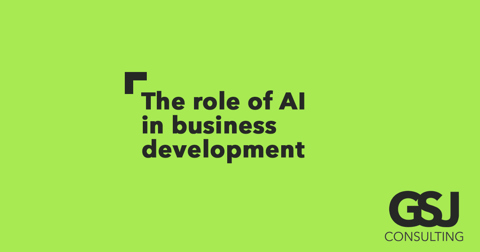The future role of AI in business development

At its core, business development in professional services is about people. We are, and will remain, a people-to-people business. Your network, your relationships, and your ability to convert opportunities into actual work are still reliant, in a large part, on your likability. That’s not going to change anytime soon.
Despite what people might be telling you about the wonders of artificial intelligence (AI), the art of building trust, listening to client needs, and staying front-of-mind will still require the human touch for years to come.
But - and there is always a but, that doesn’t mean professionals should ignore tools that can make their lives easier. We should not be Luddites - can you imagine doing business development today without your smartphone; CRM or social media, like LinkedIn?
AI should be seen as simply the next evolution of this development: a tool that, if used properly, can help you build more meaningful relationships, make better decisions and support you to develop a more sustainable practice.
AI as your behind-the-scenes assistant
AI isn’t here to replace you at client-facing events or meetings. But fortunately, it can take on the repetitive, time-consuming tasks that prevent you from doing what really matters: connecting.
Practical examples of how you can use AI as a business development support manager include:
- Summarising publicly available client-related information, such as stock market updates, news items and client publications.
- Generating first drafts of capability statements.
- Organising CRM data to identify dormant clients or leads.
- Analysing win/loss data to reveal why some pitches succeed and others don’t.
- Transcribing telephone, Teams and other calls you may have with your team and clients.
AI’s real value is in turning data into insight, allowing you to prioritise your time and focus on the highest-value relationships.
Smarter networking and relationship intelligence
Professionals thrive on networks, but it’s easy to lose track of who knows whom (WKW). Tools powered by AI (like Affinity or ClientSense) analyse communication patterns to surface “warm paths” into target clients.
Imagine being able to see:
- who in your firm has the strongest connection to a prospective client;
- which key clients haven’t been contacted in six months;
- where cross-selling opportunities are being missed.
Importantly, utilising AI can help you map your firm’s relationship capital; something that used to live in partners’ heads as a result of their distrust in the CRM systems of yesteryear. All of this should help you turn opportunities into something visible, measurable and actionable.
Pricing, forecasting and client targeting
AI can also help your business development efforts by:
- looking at model alternative fee arrangements (e.g., fixed, retainer, subscription) that are or can work for your practice;
- forecasting revenue under different pricing scenarios;
- analysing client profitability and identifying margin-erosion risks;
- detecting patterns in client churn or complaint data.
This helps turn pricing and client strategy from guesswork into a data-driven discipline!
The future: AI for insight, humans for influence
Professionals who will thrive in the next decade are those who embrace a blended approach:
“Human Trust × Machine Intelligence”
AI will handle the analytics, automation and pattern recognition. Humans will remain the storytellers, negotiators and trust builders.
In a nutshell
You don’t need a huge investment in a data-science team. Start with small wins:
- Use AI to summarise client feedback.
- Automate contact tracking in your CRM.
- Experiment with generative AI for first-draft marketing or proposal content.
- Integrate relationship-mapping tools across your firm.
Each step frees up more time for the one thing AI can’t replicate: human connection.
Contact GSJ Consulting
We can help you Aquire, Retain, Grow
The information contained in this article is of general nature and should not be construed as professional advice. If you require further information, advice or assistance for your specific circumstances, please contact us.
